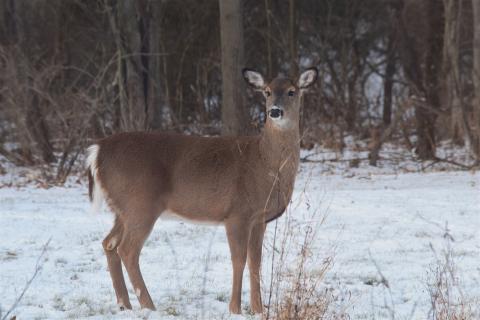Keep The Deer Out Of Your Garden This Winter

Throughout much of New Hampshire, white-tailed deer have become a major garden and landscape pest. When food is scarce in winter months, deer will heavily browse on some evergreen plants, including arborvitae (Thuja occidentalis) and yew (Taxus sp.). Fortunately, there are three key strategies you can implement to limit deer damage in your garden.
Preventing Deer From Getting Into Your Garden
Excluding deer from the garden is by far the most successful management tool homeowners can employ. Electric fencing is one effective option. A single shock may be enough to train a deer to keep away from the garden. Just make sure that the fence is visible to both deer and people.
If you’re concerned about pets or children coming into contact with an electric fence, you can try constructing an upright one. If you choose this method, pay attention to how tall the fence is. White-tailed deer are capable of jumping up to eight feet high, so fences must reach at least this height. There are dozens of different fencing materials that will work, including wood, wire, and mesh. Wooden privacy fences have the added benefit of preventing deer from seeing into your garden. Another option is heavy-duty plastic netting, which can be quite cost effective and is fairly easy to work with.
If there is one particular plant in your landscape that the deer find particularly appetizing, you may find that it’s more economical to build a cage around that individual plant. Simply drive a few stakes into the ground and surround those securely with mesh.
Of course, erecting a fence at this point in the season may not be terribly realistic, but it is something worth considering in the spring or summer, especially if deer are a persistent issue in your area. Once the ground is frozen, repellents are the next best option for protecting vulnerable landscape plants.
Using Repellents On Plants In Your Garden
Applying repellents is another way of dealing with deer. The efficacy of repellents depends on how they are used, and frequent reapplication is often necessary. Many repellents lose their effectiveness after rainfall or simply after a certain amount of time. Even in the best of circumstances, repellents will never completely eliminate deer damage, but should help reduce it if they are applied and used according the instructions.
Contact repellents are applied directly to plants and deter deer by odor, taste, or both. Many commercial formulations are composed of smelly and distasteful substances such as dried blood, putrescent egg solids, garlic, and coyote urine. Unsurprisingly, many of these repellents have a truly repulsive smell that you may find unsuitable for use directly around the home.
If foundation plantings are suffering from heavy deer browse, area repellents placed in the vicinity of plants may enough to deter deer. Although these types of repellents are usually less effective than contact formulations, their odor isn’t nearly as offensive. Bar soap, “garlic sticks”, and bags of human hair are frequently clipped or hung from the branches of plants that deer enjoy. If deer are only an occasional issue in your garden and there are plenty of other desirable food sources nearby, you may find that area repellents will meet your needs.
Be aware that if deer are hungry enough, even the strongest repellent won’t keep them away.
Selecting Deer Resistant Plants
Some plants are more appetizing to deer than others. Yews and arborvitaes are generally irresistible to deer, while hollies are largely avoided. Utilizing plants in the landscape that are more deer resistant is a good way of limiting damage. Deer tend to avoid plants that are hairy, spiny, tough, or particularly aromatic. If there are certain plants in your landscape that the deer just can’t get enough of, it may be simpler to replace them than fuss with trying to protect them. Again, keep in mind that almost no plants are entirely safe from hungry deer.
The most important thing to remember is that all deer-proofing methods are more effective when they are used before deer problems start. Once deer learn to associate your garden with tasty plants, they will keep coming back. However, if you deter them from your yard and garden early in the season, you’ll save yourself a lot of hassle and your plants will have a chance to thrive.
Got questions? The Ask UNH Extension Infoline offers practical help finding answers for your home, yard, and garden questions. Call toll free at 1-877-398-4769, Monday to Friday, 9 a.m. to 2 p.m., or e-mail us at answers@unh.edu.
Related Resource(s)
Do you love learning about stuff like this?
SUBSCRIBE TO Granite State Gardening newsletter
Got questions? The UNH Extension Yard and Garden Infoline offers practical help finding answers for your yard and garden questions.
Call toll free at 1-877-398-4769, Monday to Friday, 9 a.m. to 2 p.m., or fill out webform.